I can't think of any stage in a phono preamp where a 12AU7 would be an appropriate choice, except maybe a low gain output stage. Even there there a better valves.
The 'U7 makes an OK buffering cathode follower at the phono preamp's O/P and its utility for this job ends there.
-------------------------------------------------------------------------------------
Brian,
Olof summed the situation up very well. The 12AU7 is unsuited to the gain, noise, and linearity requirements of phono section voltage amplification. Pick another type! Obvious contenders include the 12AX7 and the 6922.
Good Day to All,
Are there any good schematics for a phono stage that uses only the 12AU7?
Thanks in advance.
Cheers
Brian
I have made one 10 years ago which is good if you like 12AU7 and you can handle 18dB gain. Has 5R4GY or analogous rectifier, MKP CLC and a Mosfet Maida reg for PSU. Pictured with Russian NOS rectifier and Tangsol NOS 12AU7s.
Attachments
Hi,
I'm quite new to this forum, but not new to audio designs. Have been professional since the 1960's.
The following thoughts IMO about this:
A good 12AU7/ECC82 has a very, very low input-, flicker- and shot- noise. Specially the down-rated? and low priced Philips-Sylvania, during the 80's manufactured 6189's, that seems to have a very good and stable cathode emission coating. Sucsessfully used in some famous capacitor microphones!!
But the amplification factor is far to low for a passive RIAA network to follow, where you lose around 20dB in gain at 1 KHz. So the termal noise in the equalizing network will be very dominating and audiable.
The little higher distorsion of this tube is no problem at these signal levels, but it's still only suitable for the output stage. Preferebly in a 2-tube SRPP or an u-stage, where the distorsion is minimized by the light load on the voltage amplifier tube and the output impedance is lowered in the cathode follower section.
For the input stage (in a passive tye RIAA) are only tubes with a u (amplification factor) of 60 to 100 suitable, to overcome the termal noise in the EQ-network. 12AX7/ 7025/ ECC83/ E83CC/ 5751/ 6SL7 & similar clones are the choice.
Remember now, when we easily can use clean DC for heater voltage, the special & expensive low hum tubes, with special shielding and spiraled heater wires, has no advantage to ordinary ones.
Has anybody tried to use the the very low priced 12AT7/ECC81 as the input tube?
They should have a comparably low microphonic sensitivity, as they were used as FM-receiver oscillator in radio receivers long ago. Distortion is quite high in this tube, but still, at these signal levels absolutely low enough.
JohanB
I'm quite new to this forum, but not new to audio designs. Have been professional since the 1960's.
The following thoughts IMO about this:
A good 12AU7/ECC82 has a very, very low input-, flicker- and shot- noise. Specially the down-rated? and low priced Philips-Sylvania, during the 80's manufactured 6189's, that seems to have a very good and stable cathode emission coating. Sucsessfully used in some famous capacitor microphones!!
But the amplification factor is far to low for a passive RIAA network to follow, where you lose around 20dB in gain at 1 KHz. So the termal noise in the equalizing network will be very dominating and audiable.
The little higher distorsion of this tube is no problem at these signal levels, but it's still only suitable for the output stage. Preferebly in a 2-tube SRPP or an u-stage, where the distorsion is minimized by the light load on the voltage amplifier tube and the output impedance is lowered in the cathode follower section.
For the input stage (in a passive tye RIAA) are only tubes with a u (amplification factor) of 60 to 100 suitable, to overcome the termal noise in the EQ-network. 12AX7/ 7025/ ECC83/ E83CC/ 5751/ 6SL7 & similar clones are the choice.
Remember now, when we easily can use clean DC for heater voltage, the special & expensive low hum tubes, with special shielding and spiraled heater wires, has no advantage to ordinary ones.
Has anybody tried to use the the very low priced 12AT7/ECC81 as the input tube?
They should have a comparably low microphonic sensitivity, as they were used as FM-receiver oscillator in radio receivers long ago. Distortion is quite high in this tube, but still, at these signal levels absolutely low enough.
JohanB
Last edited:
I would not use it for a cathode follower - gm too small, so high distortion and high output impedance.
It works OK for that application. At the end of the day its gm is not so lower than that of a 6SN7 and you typically get around 400 ohms Zout. Pretty good for driving 99% of line preamps. Distortion is low if you bias it "properly" and the signal level is quite low in a phono preamp.
45
Has anybody tried to use the the very low priced 12AT7/ECC81 as the input tube?
They should have a comparably low microphonic sensitivity, as they were used as FM-receiver oscillator in radio receivers long ago. Distortion is quite high in this tube, but still, at these signal levels absolutely low enough.
JohanB
The real ECC81 is much better than that described in data sheets. Actually this is true for many "poor" tubes! You can get several volts with very low distortion if it doesn't have to drive heavy loads....
However I have no experience with this valve in a phono preamp - or better with many valves in general - as I switched to SS phono preamps a long time ago....
45
I have used an ECC81 as the first stage in a modified 5-10 power amp, to replace the EF86. Signal levels at low volume are not much higher than a phono input. Noise is very low. Gain is high enough to overcome noise in a passive RIAA network, and the low anode impedance means that the network can be lower impedance than one driven from an ECC83.
However, we need to bear in mind that a valve which is designed for low noise at VHF is not necessarily low noise at audio frequencies, as it depends on where flicker noise starts to be a problem. Flicker noise depends on details of cathode construction, so can vary significantly for the same nominal valve type.
I would only use an ECC82 (or 6SN7) as a cathode follower if I happened to have a spare triode available, and it was a non-critical position. I am surprised by the number of people who use it. I suspect that some of them are confused: they may think that having a low anode impedance means that it is a 'low impedance' valve so OK for CF service. If I had to add an extra valve anyway then ECC81 or ECC88 would be better.
However, we need to bear in mind that a valve which is designed for low noise at VHF is not necessarily low noise at audio frequencies, as it depends on where flicker noise starts to be a problem. Flicker noise depends on details of cathode construction, so can vary significantly for the same nominal valve type.
I would only use an ECC82 (or 6SN7) as a cathode follower if I happened to have a spare triode available, and it was a non-critical position. I am surprised by the number of people who use it. I suspect that some of them are confused: they may think that having a low anode impedance means that it is a 'low impedance' valve so OK for CF service. If I had to add an extra valve anyway then ECC81 or ECC88 would be better.
If we go examine the equivalent noise resistance of triodes for use in phono head amp then ECC81 is 3 nVrtHz when ECC83 is 5.6 nVrtHz. Any Rk and grid stopper will push it up. We generally look for high gm low Rp. Some pentodes like E810F or D3A can go low enough en when trioded and holding enough gain still. I would highly recommend to read SY's ''His Master's Noise'' article, has an excellent and easy to follow intro on phono tube head amps and noise concerns. SY'S link.
Amplifying from MC level with tubes competently is out of the question without help of an input transformer. That is low Rbb BJTs and paralleled high gm JFETs territory.
Amplifying from MC level with tubes competently is out of the question without help of an input transformer. That is low Rbb BJTs and paralleled high gm JFETs territory.
Where do you get these figures from?If we go examine the equivalent noise resistance of triodes for use in phono head amp then ECC81 is 3 nVrtHz when ECC83 is 5.6 nVrtHz.
By the size of them I suspect you used the old EIR = 2.5/gm formula. Does anyone know the origin of this formula, as I find it highly dubious, at room temperature anyway... (Yeah I know it's in RDH4, but it's not referenced.)
Last edited:
There's actually an excellent derivation of the 2.5/gm approximation for triodes in Elmore and Sands.
You mean this book?
http://www.archive.org/details/Electronics-experimentalTechniques
(still looking for the derivation)
Last edited:
Amplifying from MC level with tubes competently is out of the question without help of an input transformer.
I AGREE. However, that does not stop people from trying, with things like the 12AX7.
JMO, use either a SUT or a hybrid cascode (ala Allen Wright), with LOMCs.
Where do you get these figures from?
By the size of them I suspect you used the old EIR = 2.5/gm formula. Does anyone know the origin of this formula, as I find it highly dubious, at room temperature anyway... (Yeah I know it's in RDH4, but it's not referenced.)
From Vogel's ''Sound Of Silence''. RNtriode=3.06/gm for cathode temp 1100K, room temp 300K.
U. Pictured with Russian NO
NNIICCEE !!
Looks like your packing more iron than Dirty Harry with that little baby dude !
Simon...
Anyone ever checked out the 12AD7, got a matched pair here waiting for a job to do.
Simon.
High impedance low gm (1.6). Can do as good as an ECC83. Its low microphony and hum special though, and preferable when signal is low.
- Status
- This old topic is closed. If you want to reopen this topic, contact a moderator using the "Report Post" button.
- Home
- Amplifiers
- Tubes / Valves
- 12AU7 Phono Stage
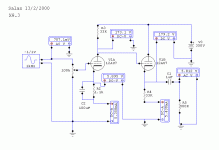
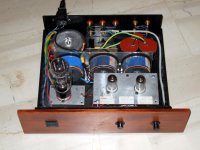
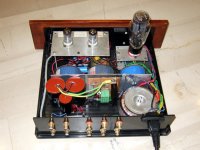
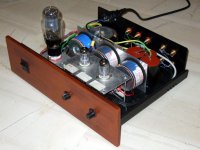
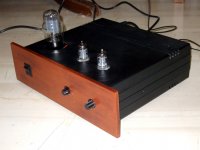
 Too blind! Anyway, 12AU7 is not suitable for phono stage.
Too blind! Anyway, 12AU7 is not suitable for phono stage.